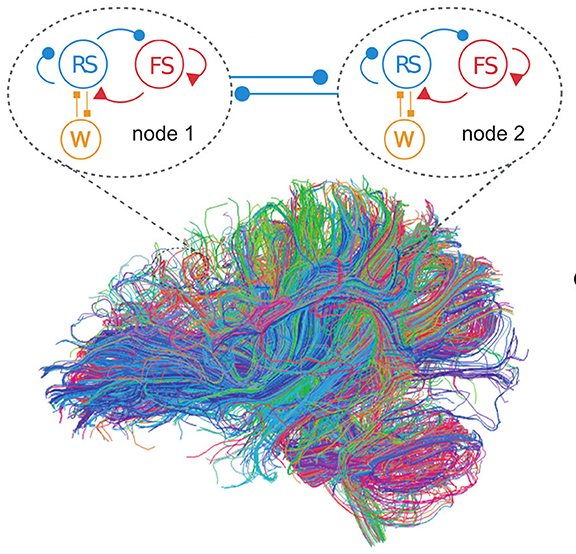- Research News
HBP researchers simulate dynamics of different states of consciousness
27 July 2023
In a recently published study, HBP researchers from France simulate slow-wave sleep and wakefulness brain states across multiple scales using EBRAINS. The findings are published in Frontiers in Computational Neuroscience.
HBP researchers from Paris-Saclay University and Aix-Marseille University in France demonstrated that they were able to simulate neural dynamics of different consciousness states, using The Virtual Brain (TVB), which is available via the HBP’s infrastructure EBRAINS as an open-source platform for constructing and simulating personalised brain network models.
The team took a multi-scale approach in order to achieve an integrated understanding of neural activity patterns.
For this construction of a whole-brain model from the ground up, the theorists started at the neuron level, with a biophysical model called Adaptive Exponential (AdEx) integrate and fire. Then they moved to the neuronal population level, or mesoscale, which was captured by mean-field models of networks of AdEx neurons, each representative of a tiny area of brain tissue, like a pixel in a camera.
The next step, towards macroscopic scale, was to integrate the mean-field models to model phenomena at the scale of several brain areas, up to the entire brain. For this, they used TVB as a simulation platform, incorporating the mean-field models into a large network of mean-field units constrained by the entire human brain connectome, to create the TVB-AdEx.
These new TVB-AdEx models can simulate microscopic processes, like changes in spike frequency adaptation – the synchronised periods of silence and activity observed in neural assemblies during unconsciousness. Simulating microscopic changes and observing the effects on the macroscopic whole-brain scale, the team found they were able to capture the dynamics of both unconscious-like slow-wave and conscious-like asynchronous, irregular dynamics on the whole-brain macroscopic level.
In other words, changes at the microlevel could reproduce brain-state dependent dynamics at the whole-brain macrolevel. “If we change the spike frequency adaptation, or do other manipulations at the microscopic scale in the model, we can see the emergence of global rhythms that are associated with sleep or wakefulness, the more synchronous or asynchronous regimes. We study the emergence of different patterns based on these microscopic changes,” says Jennifer S. Goldman, postdoctoral fellow and lead author of HBP studies at the Paris-Saclay University, CNRS. Thus, with their new plugins for the TVB platform, the researchers demonstrated a scale-integrated understanding of different states of consciousness and some of their underlying mechanisms.

Connection of AdEx mean-field models in The Virtual Brain. Each mean-field model consists of two populations, excitatory RS (blue) and inhibitory FS (red) neurons, taking into account spike-frequency adaptation for excitatory neurons (W, orange). Image: Goldman et al. Front Comput Neurosci (2023).
“This is the first time that one has the tools to predict global changes in brain activity following changes at the level of synaptic receptors, which can be applied to anaesthesia, drug actions, pathologies, or even to predict ways to restore consciousness in patients suffering from brain lesions”, says Alain Destexhe, research director at CNRS in Paris-Saclay University.
“In the future, more detailed patient data – genomic, proteomic, or metabolomic data – can be included to improve the accuracy and predictive power of personalised models”, says Goldman.
Text by Matthijs de Boer
Reference
Jennifer S Goldman, Lionel Kusch, David Aquilue, Bahar Hazal Yalçınkaya, Damien Depannemaecker, Kevin Ancourt, Trang-Anh E Nghiem, Viktor Jirsa, Alain Destexhe. A comprehensive neural simulation of slow-wave sleep and highly responsive wakefulness dynamics. Front Comput Neurosci 2023 Jan 13;16:1058957. doi: 10.3389/fncom.2022.1058957



